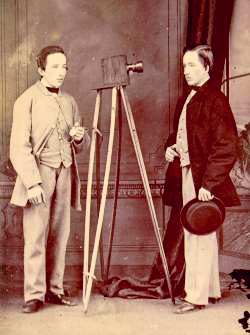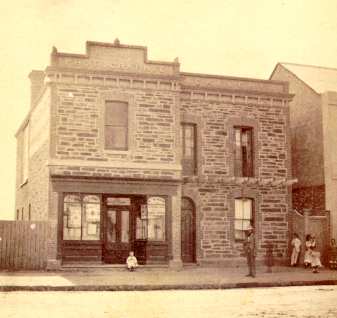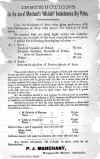 |
Philip
James MARCHANT Left: This rare and well-executed double
portrait of Philip Marchant was taken when he was about seventeen years of age. On the
left he is the photographer timing the exposure with his watch, and on the right he plays
the part of the person having his portrait taken.
(Text below) |
Philip MARCHANT was born at Charmouth in Devon,
England, on 19 December 1846. His father, John Adams Marchant was a miller, and a few
weeks before Philip’s fourteenth birthday the family left London on the 613 ton
sailing ship Harwich bound for South Australia where John Marchant had a contract
to manage Walter Duffield’s Victoria flour mill at Gawler. After a voyage of 13 weeks
the Harwich anchored off Semaphore on 17 February 1861.
After living at Gawler for two years the family moved to Adelaide where
John Marchant leased the Light Square flour mill and the house and shop next door, and it
appears that at about this time Philip learned the art of wet-plate photography. In
September 1864, at the age of 17 years, Philip Marchant left Adelaide on a photographic
excursion to hills districts south of the city. With him were two companions, one named
Webb and the other named Harry, who was probably his younger brother Henry, commonly known
as Harry.
The excursion commenced on 6 September and ended on 4 November, and
sketchy details were recorded in a pencil diary kept by Philip. (see MARCHANT
DIARY) They travelled through Echunga to Macclesfield, then on to Mount Barker and
Nairne, picking up whatever photographic work they could on the way, eventually settling
at the Bremer copper mine (Callington) for several weeks before returning home. One of the
greatest difficulties they faced was the weather. Because they had no permanent studio and
no doubt took portraits out in the open against a temporary backdrop, there were many days
when they were unable to operate because it was either too wet or too windy, or both. On
some days they had to turn away customers because of the weather, on others the weather
was fine but the customers did not come. On a few rare occasions they were busy all day
with no time to stop for dinner.
The diary also contains a list of Philip Marchant’s stock on hand
as at 14 November 1864. He had three cameras: a whole-plate camera for views, and one
half-plate and one quarter-plate for taking portraits. A piece of carpet and a background
appear to be all he had to create the illusion of a studio; a ‘looking-glass’
for customers to check their appearance; a ‘darkhouse’ for sensitising and
developing his plates; a box of paints and tube of gold powder for colouring photographs;
a ‘diamond’ for cutting glass to size; a long list of chemicals and photographic
glassware; several dozen cases for ambrotypes; carte de visite frames and albums; hobbles
for the horse, a tomahawk and a baking tin.
Philip Marchant was the first in the family to become a photographer,
and was followed by another five Marchants over three generations who operated
photographic studios continuously for a period of 110 years (see MARCHANT
FAMILY).
In March 1866 Philip Marchant opened a studio in Waymouth Street,
Adelaide, presumably in the shop rented by his father. He advertised: ‘If you would
have a good and cheap portrait, call at P.J. Marchant’s, next to Light Square Mill,
Waymouth Street.’ In the same month he assembled a mosaic of 29 carte de visite head
and shoulder portraits titled ‘Members and Representatives of the Bible Christian
Meeting, Adelaide. March 1866.’ Each portrait was numbered and named.
On New Year’s day in 1869 Philip Marchant married Mary Bowering, a
straw hat and bonnet maker, and by the end of January the couple had moved into ‘more
commodious premises’ at 164 Rundle Street, opposite the York Hotel, where Philip had
‘erected a first-class studio.’ He thanked his customers for their ‘liberal
support during the past three years’ and asked for their patronage at his new
establishment. Carte de visite portraits, he said, were 12 shillings per dozen. Mrs
Marchant also moved her straw hat and bonnetmaking business to their Rundle Street
premises, where she advertised, ‘feathers cleaned, dyed and curled.’
By December 1871 Philip Marchant had reduced the price of his cartes de
visite to 10 shillings per dozen, with the added bonus of receiving 14 to the dozen, or 6s
6d per half dozen. In 1871 he purchased a property on the north side of Waymouth Street, a
little east of Light Square where, in February 1872, he advertised ‘Marchant’s
Photographic Gallery’. Now that his ‘first-class premises’ were finished,
he said, he hoped his customers would continue to patronise him at the new address. After
he moved to Waymouth Street the studio at 164 Rundle Street was occupied by William James
Lott (q.v.) who was without doubt South Australia’s most notorious photographer.
 |
Left:
Philip Marchant's "Photographic Gallery" in Waymouth Street c.1872. The large
window on the left wall of the building, upstairs, indicates the location of the
photographic studio. |
In the late 1870s dry-plate technology was beginning to replace the
old, inconvenient and technically demanding wet-plate process. While photographers
overseas were able to take advantage of the new plates as soon as they were available,
they did not gain immediate acceptance in Australia. Batches of the plates were often
spoiled by the time they reached Australia, due to the effects of aging on the voyage to
Australia and the effect of heat and humidity while passing through the tropics.
Philip Marchant experimented with the manufacture of dry plates and by
August 1880 had enough confidence in his product to be able to offer them for sale –
without doubt the first commercial dry plates made in Australia. His advertisement said:
‘Babies, or anyone else, photographed by my extraordinary quick process, in sunshine
or dull weather, any style and position, beautifully burnished. 14 cards for 7s 6d.
Photographers supplied with the guaranteed Adelaide Instantaneous Gelatine Dry Plates, all
sizes; and they are invited to come and test them free of charge. P.J. Marchant, Waymouth
Street.’ On the instruction sheet packed with his plates Philip Marchant recommended
an exposure equal to one-seventh the time used for a wet-plate.
 |
Left: Instruction sheet for Marchant's Adelaide
Instantaneous Dry Plates, believed to be the first commercially made dry-plates in
Australia.
If you wish to see the fullsize image to read the instructions,
click on the thumbnail image at left and the full size image will load (79 kbytes). You
will then be able to read Philip Marchant's instructions. Return to this file by pressing
your browser BACK button. |
On 30 August 1881 George Freeman of the Melbourne Photographic Company
in Rundle Street photographed fifty-five members of the Theatre Royal company at a picnic
near the rocks at Brighton (another item says Marino). The picture was described as
‘an excellent specimen of instantaneous photography taken by means of gelatine plates
specially prepared by Mr Marchant.’ The exposure had ‘occupied a second of
time’ and a report said ‘the likeness of each individual is very clear and
distinct.’
By July 1882 Philip Marchant had purchased the luxurious 12-room Gawler
residence of the late James Dawson, known as ‘Mars Hill’, and had also taken a
shop in Murray Street for a ‘photographic atelier,’ adjoining the Bank of
Adelaide and next to Betts’s boot shop. He continued making his Adelaide Dry Plates
at Mars Hill, but eventually ceased production for a number of reasons. It is said import
duty on glass was one reason, and the improved keeping-qualities of cheaper imported
dry-plates another. His photographer-son Ebenezer once said that his father ‘was a
photographer, not a chemist,’ and that while he was able to produce batches of plates
which were of uniform sensitivity, the degree of sensitivity varied from one batch to
another.
Philip Marchant opened his Gawler studio for business in October 1882,
and in November he advertised that he had ‘erected a first-class studio’ and
possessed ‘all the latest appliances’ which enabled him to confidently solicit
public patronage. ‘Special attention given to baby portraiture. Prices from 10s. per
dozen. Outdoor groups, carriages, animals, &c., photographed by the instantaneous
process, by appointment, on the grounds at my private residence, Mars Hill. Portraits
copied, and enlargements made up to life size. Manufacturer of the Adelaide Instantaneous
Dry Plate.’ In February 1883 the Bunyip said that his photograph of the
unveiling of the Dawson memorial was ‘very clear and distinct, and the features of a
great many are easily recognised. This picture adds one more to the many Mr Marchant has
taken of places in Gawler, and proves him to be an artist of no mean order.’
In December 1884 Philip Marchant moved his photographic business to a
studio opposite the Bunyip printing office which had previously been occupied by
another photographer, James Taylor (q.v.), who had moved to Port Augusta. Business must
have been dull because here, at his ‘Gawler Portrait Rooms and Musical Instrument
Repository’, he was prepared to photograph ‘anyone that will favour him with a
sitting provided they will take one copy at the following prices – Cabinets 2s and
carte de visite 1s.’ Gone was the usual dozen or half dozen order, and extra copies
were at half the price of the first single copy.
In July 1886 Philip Marchant moved his business to Cowan Street,
directly opposite Hilfers & Co.’s flour mill, his third Gawler studio in four
years. Here he advertised a charge for proofs (q.v.): ‘New studio erected and lighted
according to the latest improved design, afternoon light especially good. Prices –
Cabinet, 15s per dozen, proof 5s.; Carte de Visite 7s 6d per dozen, proof 2s 6d.’
Nine months later Philip Marchant’s household goods and some
photographic apparatus was offered for sale by auction as he was about to leave Gawler. At
a farewell social ‘a very eulogistic address accompanied by a purse of
sovereigns’ was presented on behalf of the Baptist Church and Sunday School where he
had been organist and librarian.
Philip Marchant and his family moved to Latrobe in Tasmania and on 21
June 1887 he opened the Latrobe Photographic Studio, where his wife Mary also resumed her
trade of feather dressing. In addition to Philip and his family his parents, two married
sisters, two of his married brothers and six children all moved to Tasmania in the next
few weeks. A few months after arriving in Tasmania Philip and Mary Marchant’s last
child was born, Ebenezer Tasman Marchant, then three years later Mary contracted
tuberculosis and died, leaving Philip with a family of eight children whose ages ranged
from 20 years to 2 years and 10 months.
Below: Philip
Marchant's studio at Latrobe, Tasmania. |
 |
Life in Tasmania was difficult for the Marchant family. There was a
period of depression, trade was slow, and eventually Philip’s parents and some other
members of the family returned to South Australia. Finally, in April 1895, Philip Marchant
held a sale of household goods ‘prior to leaving the Colony.’
Philip Marchant returned to Gawler where he once again opened for
business as a photographer. He rejoined the Baptist Church as organist and librarian but
after a few years his health began to fail and the running of the business was left to his
youngest son, Ebenezer. On 23 December 1904 he advertised in the Bunyip:
‘Marchant’s Studio, Gawler. – Many and sincere thanks to all who have
favoured me with their patronage in years gone by, and now again I ask for a continuance
of their support, also wish them to note our price and see our specialties in up-to-date
photography in 1905. P.J. Marchant, temporary address, Glenelg.’ He was nursed
at home by two of his daughters, one of whom wrote in a letter, ‘The doctor said he
is better today, but I would like to know where.’ Philip Marchant died on 7 August
1910 and was buried in the Gawler cemetery.
End.



